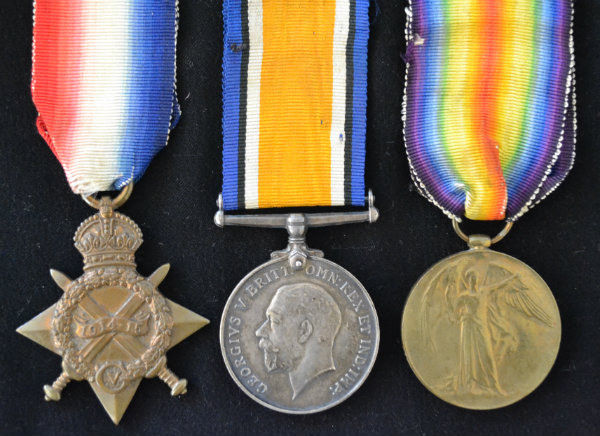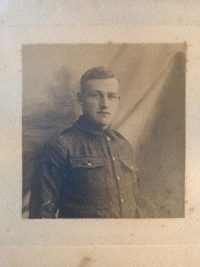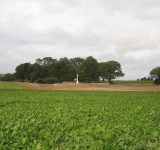Personal Details
Born in Darlaston, near Fauls, Shropshire in 1896 (his birth was registered in the 3rd quarter 1896), the third son of William and Sarah Wallace of Darlaston, Prees, Whitchurch, Shropshire. (Note that the CWGC certificate incorrectly states his age)
The 1911 Census shows Wallace as an assistant cowman on a farm; he subsequently worked at Crewe Railway Works.
Wallace entered France on 8 August 1915 and was killed along with 7 other soldiers from his regiment from a German shell.
Military Details
Regiment : 6th Battalion King’s Shropshire Light Infantry
Rank : Private
Service Number : 15791
Killed in action; France 10 August 1916 Aged 19

The 1914 Star (also known as 'Pip') was authorised under Special Army Order no. 350 in November 1917 and by an Admiralty Fleet Order in 1918, for award to officers and men of the British and Indian Expeditionary Forces who served in France or Belgium between 5 August and midnight of 22–23 November 1914. The former date is the day after Britain's declaration of war against the Central Powers, and the closing date marks the end of the First Battle of Ypres.
The 1914–15 Star (also known as 'Pip') was instituted in December 1918 and was awarded to officers and men of British and Imperial forces who served against the Central European Powers in any theatre of the Great War between 5 August 1914 and 31 December 1915. The period of eligibility was prior to the introduction of the Military Service Act 1916, which instituted conscription in Britain.
The British War Medal (also known as 'Squeak') was a silver or bronze medal awarded to officers and men of the British and Imperial Forces who either entered a theatre of war or entered service overseas between 5th August 1914 and 11th November 1918 inclusive. This was later extended to services in Russia, Siberia and some other areas in 1919 and 1920. Approximately 6.5 million British War Medals were issued. Approximately 6.4 million of these were the silver versions of this medal. Around 110,000 of a bronze version were issued mainly to Chinese, Maltese and Indian Labour Corps. The front (obv or obverse) of the medal depicts the head of George V. The recipient's service number, rank, name and unit was impressed on the rim.
The Allied Victory Medal (also known as 'Wilfred') was issued by each of the allies. It was decided that each of the allies should each issue their own bronze victory medal with a similar design, similar equivalent wording and identical ribbon. The British medal was designed by W. McMillan. The front depicts a winged classical figure representing victory. Approximately 5.7 million victory medals were issued. Interestingly, eligibility for this medal was more restrictive and not everyone who received the British War Medal ('Squeak') also received the Victory Medal ('Wilfred'). However, in general, all recipients of 'Wilfred' also received 'Squeak' and all recipients of The 1914 Star or The 1914/1915 Star (also known as 'Pip') also received both 'Squeak' and 'Wilfred'. The recipient's service number, rank, name and unit was impressed on the rim.
Further Information
If you can provide any further information on Wallace Wilkinson please get in touch by leaving a comment below, using our Contact Form or by calling in to Whitchurch Heritage Centre.
Information provided by Whitchurch Museum and Archives



By Sybil Ruscoe
Wallace Wilkinson (King’s Shropshire Light Infantry 6th Battalion 15791) died in the Battle of the Somme on 10th August 1916 at the age of 19. Wallace and his three brothers all fought in WW1 – all the other boys, including my grandfather, Allan, all came home.
He was from the small Shropshire hamlet of Darliston, near Whitchurch, of around five to six houses and worked at the Crewe Railway Works.
His father and mother (my great grandparents), were William and Sarah, a roadman and housewife.
Sarah treasured a photograph sent by War Graves Commission of his grave in France which was a simple wooden cross with an oak sapling nearby. She never got to visit his grave. By the time I first visited the grave in 1998 on the 80th anniversary of the ending of WW1, the first member of my family to do so, that tree was a giant oak.
I took some Shropshire soil from his old garden to place at his grave. With the soil, I left a poem with the final words: ‘You couldn’t come home, so home has come to you.’
My interest in my great uncle’s sacrifice began after I read Sebastian Faulks’s novel Birdsong.
Wallace served in the 6th Battalion of the KSLI and had entered France on August 8th my birthday) 1915 and died after one year and two days in the fighting on August 10th 1916 at Courcelles.
Just days before, the KSLI history shows the men had gone into the trenches at Serre where they found them: ‘waist deep with our dead, the stench was appalling and the battalion worked day and night to bury the bodies that had lain there for eleven days.’ (quote from KSLI official history of WW1)
My friend’s father – doing his own research – found the Adjutant’s diary from the night Wallace died. He was one of eight King’s Shropshire Light Infantry soldiers killed at 11.40pm that night by enemy shelling on the front line at Courcelles. They are all buried together in Sucrerie Cemetry at Colincamps, near Albert on the Somme. My uncle’s grave gives his age as 21 but the 1901 Census shows he was born in 1897 so he would have been 19 (many boys didn’t give their true age).
The other Shropshire soldiers were E. Turner, S. Bowen, A. Jones, R. Jones, E. J. Lee, G. O’Brien, T. Heath – very much Shropshire names, like the batting order of a cricket team. I would love to hear from any relatives of these men.
My uncle is named on the War Memorial at Faul’s Church near his home and my grandmother would have passed that up to three times a day every Sunday for the rest of her life. My grandfather had a poignant tattoo on his arm which depicted him in uniform leaning on his brother’s grave.
In November 2015, my mum Celia, sister Hazel and I went to his old school – Lower Heath Primary – to talk about Wallace. The school has his name on a small memorial to the pupils who died in WW1. The children were incredibly interested to hear about him and it was so moving to read their thank you letters.
In 2016, my husband Tom, Hazel and I returned to the Somme to be at his graveside on the 100th anniversary of his death. We took a ceramic poppy from the Tower of London and left it at his grave.
We also attended the special Royal British legion service at Thiepval at 11am on August 16th 2016 where I read my poem.
Wallace Wilkinson was a treasured son and brother and he will never be forgotten by his family.
Sybil Ruscoe
November 2018
*** I would be happy to provide photos